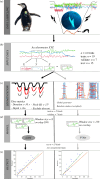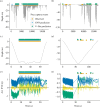Identifying prey capture events of a free-ranging marine predator using bio-logger data and deep learning
- PMID: 39100157
- PMCID: PMC11296051
- DOI: 10.1098/rsos.240271
Identifying prey capture events of a free-ranging marine predator using bio-logger data and deep learning
Abstract
Marine predators are integral to the functioning of marine ecosystems, and their consumption requirements should be integrated into ecosystem-based management policies. However, estimating prey consumption in diving marine predators requires innovative methods as predator-prey interactions are rarely observable. We developed a novel method, validated by animal-borne video, that uses tri-axial acceleration and depth data to quantify prey capture rates in chinstrap penguins (Pygoscelis antarctica). These penguins are important consumers of Antarctic krill (Euphausia superba), a commercially harvested crustacean central to the Southern Ocean food web. We collected a large data set (n = 41 individuals) comprising overlapping video, accelerometer and depth data from foraging penguins. Prey captures were manually identified in videos, and those observations were used in supervised training of two deep learning neural networks (convolutional neural network (CNN) and V-Net). Although the CNN and V-Net architectures and input data pipelines differed, both trained models were able to predict prey captures from new acceleration and depth data (linear regression slope of predictions against video-observed prey captures = 1.13; R 2 ≈ 0.86). Our results illustrate that deep learning algorithms offer a means to process the large quantities of data generated by contemporary bio-logging sensors to robustly estimate prey capture events in diving marine predators.
Keywords: accelerometer; animal behaviour classification; animal-borne video; chinstrap penguin; foraging ecology; machine learning.
© 2024 The Authors.
Conflict of interest statement
We declare we have no competing interests.
Figures





References
-
- Hentati‐Sundberg J, Olin AB, Evans TJ, Isaksson N, Berglund P, Olsson O. 2021. A mechanistic framework to inform the spatial management of conflicting fisheries and top predators. J. Appl. Ecol. 58 , 125–134. (10.1111/1365-2664.13759) - DOI
Associated data
LinkOut - more resources
Full Text Sources
